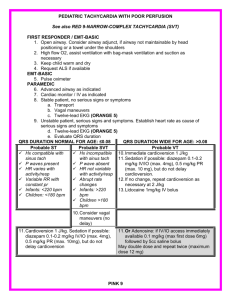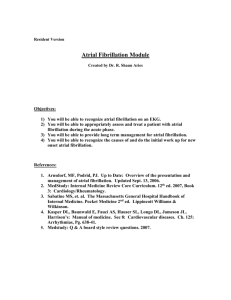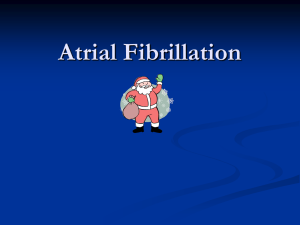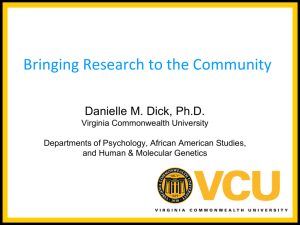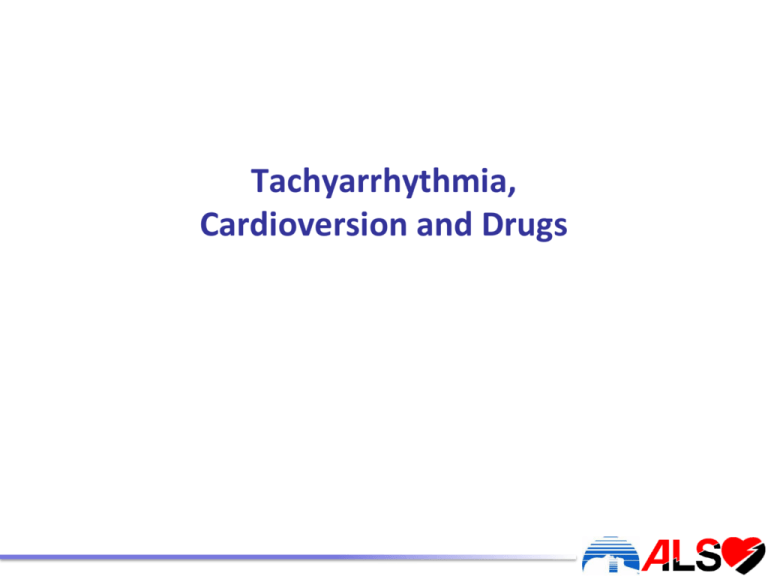
Tachyarrhythmia,
Cardioversion and Drugs
Learning outcomes
At the end of this workshop you should:
• Be able to recognise types of tachyarrythmia,
defined by regularity and QRS width
• Understand the principles of treatment
• Know the indications for electrical and chemical
cardioversion
• Know how to perform synchronised cardioversion
Conducting system
QRS Complex
How to read a rhythm strip
1. Is there any electrical activity?
How to read a rhythm strip
1. Is there any electrical activity?
2. What is the ventricular (QRS) rate?
3. Is the QRS rhythm regular or irregular?
4. Is the QRS width normal (narrow) or broad?
How to read a rhythm strip
1. Is there any electrical activity?
2. What is the ventricular (QRS) rate?
3. Is the QRS rhythm regular or irregular?
4. Is the QRS width normal (narrow) or broad?
5. Is atrial activity present?
(If so, what is it: P waves? Other atrial activity?)
6. How is atrial activity related to ventricular activity?
Sinus Tachycardia
• P waves can be hard to see on monitors
• Usually a symptom
• Does not require cardioversion
Tachyarrhythmia algorithm (with pulse)
Tachyarrhythmia algorithm
Stable broad-complex Tachyarrhythmia
Stable narrow-complex Tachyarrhythmia
Case study 1
Clinical setting and history
• 65-year-old woman
• In monitored bed 3 days after anterior myocardial infarction
• Complains to nurse of feeling unwell
Clinical course
• ABCDE
- A : Clear
- B : Spontaneous breathing, rate 26 min-1
- C : Looks pale, HR 180 min-1, BP 70/42 mmHg, CRT 3 s
Initial rhythm?
- D : Alert, glucose 5.6 mmol l-1
- E : Nil of note
What action will you take?
Case study 2
Clinical setting and history
• 48-year-old woman admitted to ED
• History of palpitation over past 12 h
Clinical course
• ABCDE
- A : Clear
- B : Spontaneous breathing, rate 16 min -1
- C : P 180 min -1, BP 110/90 mmHg, CRT < 2 s
Initial rhythm?
- D : Alert, glucose 5.5 mmol l -1
- E : Nil of note
What action will you take?
Case study 2 (continued)
Clinical course
• No response to vagal manoeuvres
• Vital signs unchanged
What action will you take now?
Case study 2 (continued)
Adenosine
Indications
• Narrow-complex tachyarrhythmia
• Regular broad-complex tachyarrhythmia of uncertain nature
• Broad-complex tachyarrhythmia only if previously confirmed
SVT with bundle branch block
Contraindications
• Asthma
Dose
• 6 mg bolus by rapid IV injection
• Up to 2 doses of 12 mg if needed
Actions
• Blocks conduction through AV node
Case study 2 (continued)
Amiodarone
Indications
• Broad-complex and narrow-complex tachyarrhythmia
Dose
• 300 mg over 20-60 min IV
• 900 mg infusion over 24 h
• Preferably via central venous catheter
Actions
• Lengthens duration of action potential
• Prolongs QT interval
• May cause hypotension
Case study 3
Clinical setting and history
•
•
•
•
76-year-old man
History of hypertension treated with a diuretic
In the recovery area after an uncomplicated hernia repair
Nurses report the sudden onset of tachycardia
Clinical course
• ABCDE
- A : Clear
- B : Spontaneous breathing, rate 18 min -1
- C : P 170 min -1, BP 100/60 mmHg, CRT < 2 s
Initial rhythm?
- D : Alert, glucose 4.0 mmol l -1
- E : Nil of note
What action will you take?
Case study 3 (continued)
Clinical course
• Patient is given IV metoprolol
• 30 min later, he complains of chest discomfort
• ABCDE
- A : Clear
- B : Spontaneous breathing, rate 24 min -1
- C : HR 170 min -1, BP 85/50 mmHg, CRT 4 s
What is the rhythm?
What action will you take?
Case study 3 (continued)
Clinical course
• Cardioversion restores sinus rhythm
• Patient is transferred back to the day-case unit
What actions may be required as part of discharge
planning?
Any questions?
Summary
You should now:
• Be able to recognise types of tachyarrythmia,
defined by regularity and QRS width
• Understand the principles of treatment
• Know the indications for electrical and chemical
cardioversion
• Know how to perform synchronised cardioversion
Advanced Life Support Course
Slide set
All rights reserved
© Australian Resuscitation Council and Resuscitation Council (UK) 2010

